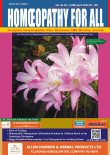Scope of Homoeopathy in Hepatocellular Carcinoma
Keywords:
scientific, countries, CarcinomaAbstract
Hepatocellular Carcinoma (HCC) is the most common cause of liver cancer. It constitutes 90% of the global incidence of liver cancer. Worldwide, the 5thcommon cause of cancer affecting human life is hepatocellular carcinoma. Approximately 7 lakh deaths are caused by HCC and makes it 3rdcommon cause of death due to cancer.1 Several reports suggest that the incidence of HCC is increasing day by day. Indian data on the epidemiology of HCC is not clearly available. Data available by national cancer registry program and by International Agency for Research on Cancer (WHO) in 2008 male and female ratio for HCC is 4:1. According to data age, presentation is 40 to 70 years. The incidence rate ranges from 0.7 to 7.5 for males and 0.2 to 2.2 per 1 lakh population. According to another report, the incidence of HCC in cirrhotic liver conditions in India is 1.6% per year.2It has been reported from the studies that chronic viral hepatitis has an important role.3,4As per the data in India 15 million people are suffering from hepatitis C virus and 45 million people are suffering from hepatitis B virus infection.5,6 Intake of alcohol is increasing gradually in India. However, the possible role of chronic alcoholism and viral infection in the causation of HCC has not been assessed in detail, but some countries have reported a positive association.7,8,9 Asians are prone to develop Diabetes type II and DM is a risk factor for the HCC in India.10In the conventional medicine liver transplant, surgical resection for the patients of single nodules with good liver function, radiofrequency ablation, transarterial chemoemboliza tion or TACE for the patients with intermediate stage of HCC and radioembolization or selective internal radiation therapy (SIRT) are the recommended treatments.In India, homoeopathic treatment is an eminent alternate and complementary treatment. Homoeopathic medicines are found effective in tackling the condition and the side effects caused by conventional treatment and in managing the hopeless cases of HCC as an Integrative therapy. In this article, we discuss the scope of homoeopathy in treating HCC with scientific evidences.
Downloads
References
EASL–EORTC Clinical Practice Guideline. Management of hepato cellular carcinoma. J Hepatol. 2012;56:908–943.
Acharya SK. Epidemiology of hepatocellular carcinoma in India. J Clin Exp Hepatol. 2014 Aug;4(Suppl 3):S27-33. doi: 10.1016/j.jceh.2014.05.013. Epub 2014 Jun 20. PMID: 25755607; PMCID: PMC4284206.
Chisari FV, Klopchin K, Moriyama T, et al. Molecular pathogenesis of hepatocellular carcinoma in hepatitis B virus transgenic mice. Cell. 1989;59:1145–1156
Idilman R, De Maria N, Colantoni A, Van Thiel DH. Pathogenesis of hepatitis B and C-induced hepatocellular carcinoma. J Viral Hepat. 1998;5(5):285–299.
Feitelson M. Hepatitis-B x-antigen in the pathogenesis of hepatocellular-carcinoma (review). Oncol Rep. 1995 Mar;2(2):193–202.
Paterlini P, Driss F, Pisi E, et al. Persistence of hepatitis B and C viral genomes in primary liver cancers from HBsAg negative patients: a study of a low endemic area. Hepatology. 1993;17:20–29.
Guptan RC, Thakur V, Sarin SK, Banerjee K, Khandekar P.Frequency and clinical profile of precore and surface hepatitis B mutants in Asian–Indian patients with chronic liver disease. Am J Gastroenterol. 1996 Jul;91(7):1312–1317
Kar, Risk Factors for Hepatocellular Carcinoma in India, Journal of Clinical and Experimental Hepatology (2014), http://dx.doi.org/10.1016/ j.jceh.2014.02.155
Austin H, Deizell E, Grufferman, et al. A case-control study of hepatocellular carcinoma and the hepatitis B virus, cigarette smoking and alcohol consumption. Cancer Res. 1986;46:962–966.
Amarapurkar DN, Amarapurkar AD. Non-alcoholic steatohepatitis: clinicopathologi cal profile. J Assoc Physic India. 2000;48:311–313
Kumar KB, Sunila ES, Kuttan G, Preethi KC, Venugopal CN, Kuttan R. Inhibition of chemically induced carcinogenesis by drugs used in homeopathic medicine. Asian Pac J Cancer Prev. 2007 Jan Mar;8(1):98-102. PMID: 17477781.
Biswas, S.J., Khuda-Bukhsh, A.R. Effect of a homeopathic drug, Chelidonium, in amelioration of p-DAB induced hepatocarcinogenesis in mice. BMC Complement Altern Med 2, 4 (2002). https://doi.org/10.1186/ 1472-6882-2-4
Es S, Kuttan G, Kc P, Kuttan R.
Effect of homeopathic medicines on transplanted tumours in mice. Asian Pac J Cancer Prev 2007;8:390-4
W. Boericke, New Manual of Homoeopathic Materia Medica & Repertory [with Relationship of Remedies], Second Re-Augmented & Revised Edition Based on Ninth Edition, Reprint Edition 2002, B. Jain Publishers, New Delhi.
J. H. Clarke, Dictionary of Practical Materia Medica, Reprint Edition 1992, B. Jain Publishers, New Delhi.
Andrew Chevallier, The Encyclopedia of Medicinal Plants, 1st Edition, 1996, Dorling Kindersley, London.
Dr. P. N. Varma, et al., A Compendium of Rare and Clinically Established Mother Tinctures, 4th Edition, Dr. Willmar Schwabe India Pvt. Ltd., A-36, Sector 60, Noida.
Mrs. Margaret Grieve, A Modern Herb, ISBN: 0486227987 & 0486227995.
Hering’s guiding symptoms of our Materia Medica By Calvin B. Knerr, M. D. B Jain Publishers Pvt Ltd; New Delhi.
Dr. Baberjea S. K. Miasmatic prescribing, Second edition. Allen College of Homoeopathy, 382, Baddow Road, Grear Baddow, Chelmsford, Essex CM2 9RA, England.




